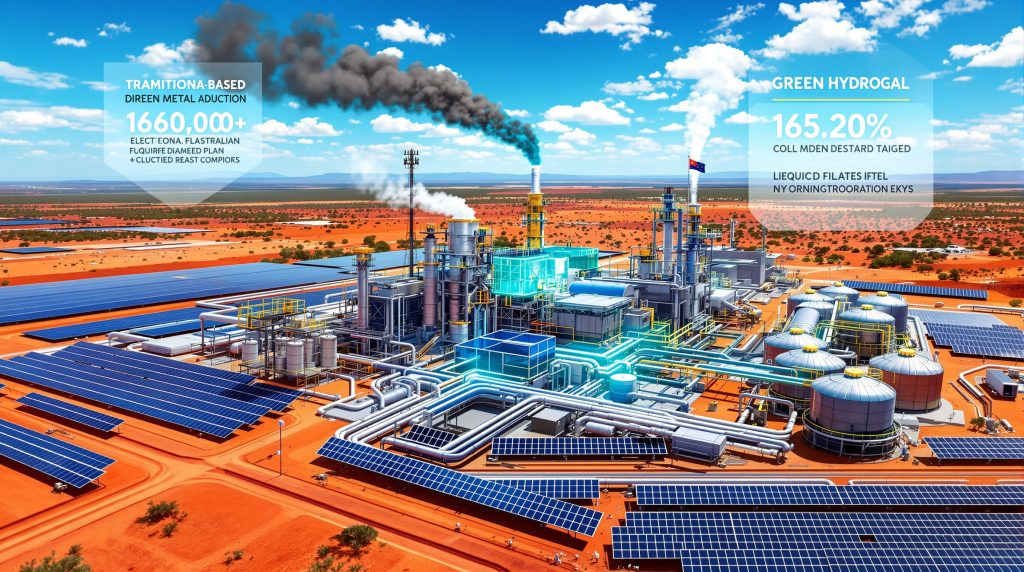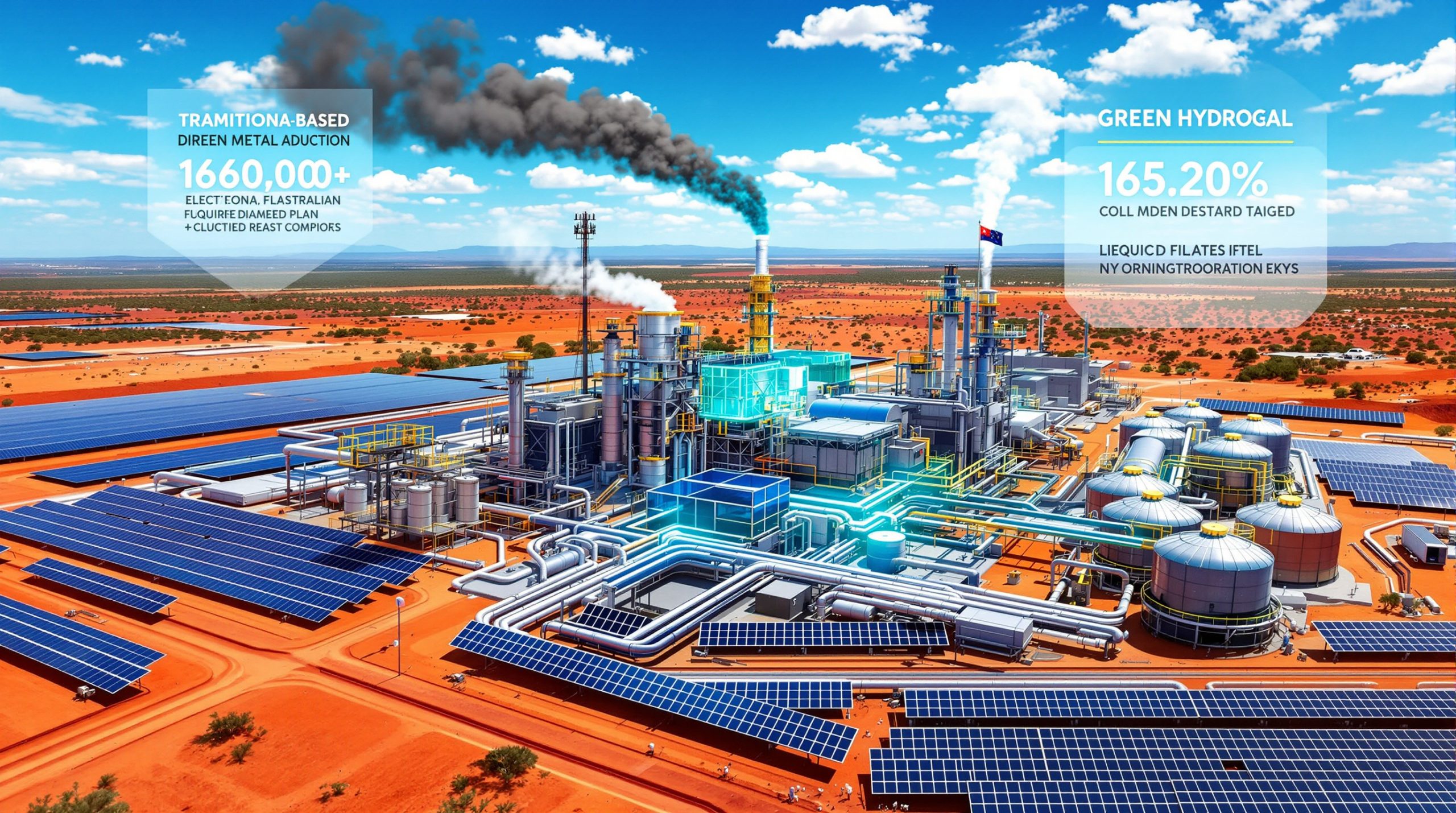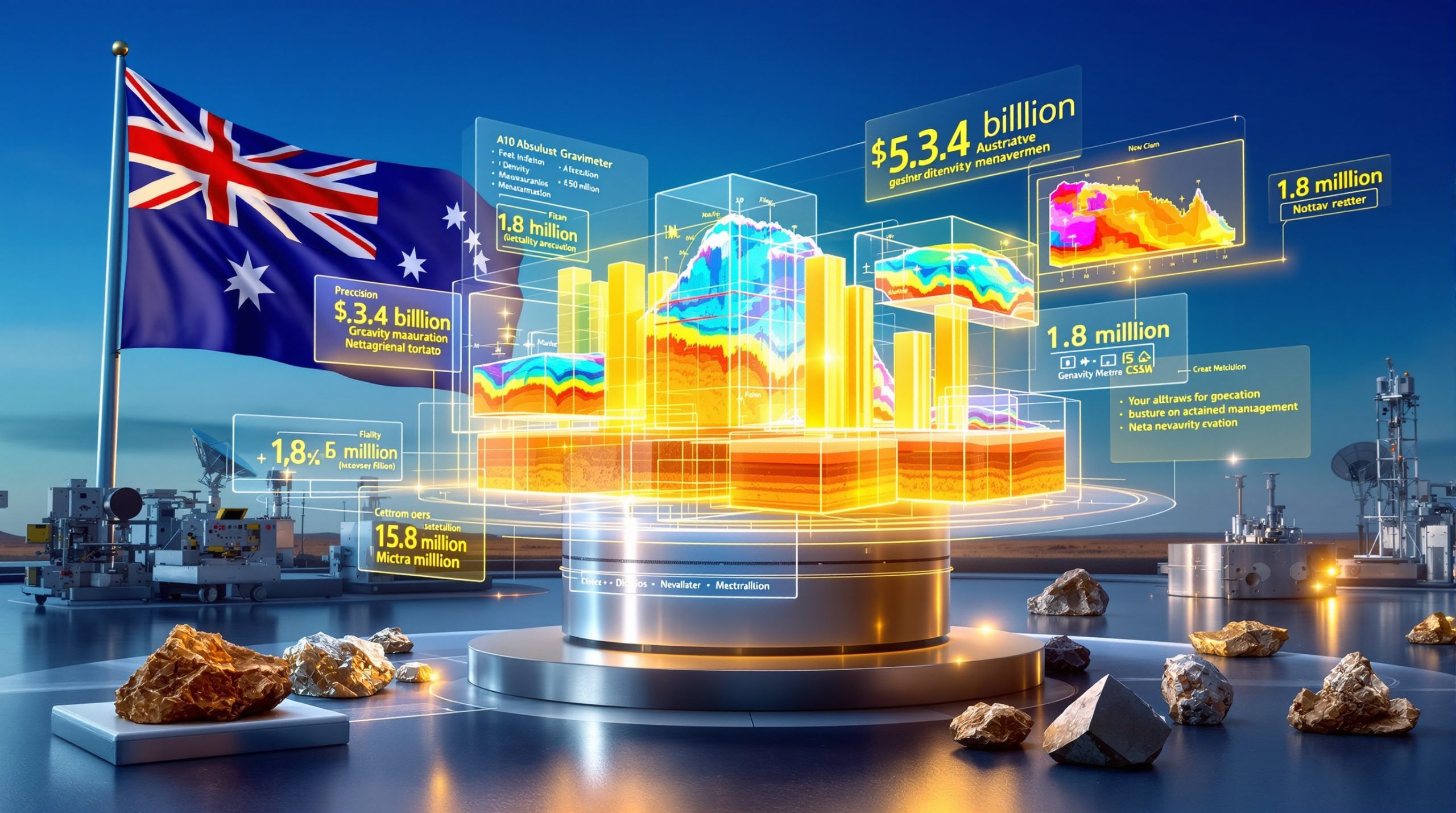Understanding Hydrogen-Based Direct Reduction Systems
The global steel industry stands at a technological crossroads, where traditional carbon-intensive production methods face mounting pressure from environmental regulations and market demands for sustainable alternatives. Hydrogen-based direct reduction represents a fundamental shift in metallurgical processing, replacing carbon monoxide with hydrogen gas as the primary reducing agent for iron oxide conversion. Furthermore, the Fortescue green metal project exemplifies this technological transformation through innovative green iron project development.
Unlike conventional blast furnace operations that rely on coal and coke combustion, hydrogen-based systems utilise renewable energy solutions to generate clean hydrogen through electrolysis processes. This transformation eliminates approximately 2.3 tonnes of carbon dioxide emissions per tonne of crude steel produced, according to Steel Watch data. The process fundamentally alters the chemical reaction pathway from carbon-based reduction to hydrogen-based reduction, where hydrogen molecules strip oxygen atoms from iron ore to produce metallic iron and water vapour as the only byproduct.
Electric smelting furnace technology complements hydrogen-based reduction by providing precise thermal control through renewable electricity rather than fossil fuel combustion. These systems operate at temperatures exceeding 1,600°C using electrical resistance heating, enabling consistent metal quality while maintaining zero direct carbon emissions during operation.
Integration requirements for renewable energy systems demand careful coordination between electricity generation, hydrogen production, and metallurgical processing schedules. Solar photovoltaic arrays must generate sufficient power to drive both electrolysis and electric smelting operations, often requiring energy storage systems to manage intermittent renewable generation patterns.
Key Performance Comparison
| Process Parameter | Traditional Blast Furnace | Hydrogen-Based System |
|---|---|---|
| Carbon emissions per tonne | 2.3 tonnes CO₂ | Near-zero direct emissions |
| Primary energy source | Coal and coke | Green hydrogen + renewable electricity |
| Ore grade compatibility | High-grade hematite preferred | Low-to-medium grade suitable |
| Water consumption | Moderate cooling requirements | Higher for hydrogen production |
| Capital investment | Lower initial costs | Higher technology integration costs |
Revolutionary Aspects of Metso's Circored Technology
Fluidised bed direct reduction mechanics represent a significant advancement over conventional shaft furnace configurations used in traditional direct reduction plants. The Circored process utilises a bubbling fluidised bed reactor where iron ore particles remain suspended in a controlled gas stream, enabling superior heat transfer efficiency and gas-solid contact compared to fixed-bed systems.
Technical specifications for the Circored system include operating temperatures between 900-950°C, significantly lower than blast furnace requirements of 1,500-1,600°C. This temperature differential reduces energy consumption while maintaining effective iron oxide reduction rates. The fluidised bed configuration allows for continuous ore feeding and product discharge, improving operational efficiency over batch-processing methods.
The Christmas Creek project represents a US$50 million pilot demonstration with installation commencing in September 2025. Annual output capacity exceeds 1,500 tonnes of direct reduced iron, providing sufficient scale for commercial viability assessment while maintaining manageable operational complexity during the demonstration phase.
Operational parameters include precise gas velocity control to maintain optimal fluidisation conditions, typically requiring superficial gas velocities of 0.5-2.0 metres per second depending on particle size distribution and bed temperature. Pressure differentials across the fluidised bed remain relatively low compared to packed bed reactors, reducing compression energy requirements for hydrogen circulation.
Technical Insight: The Circored process enables processing of iron ores with higher gangue content that traditional DRI methods cannot handle economically, expanding the range of economically viable ore reserves for steelmaking applications.
Advantages over conventional pelletisation methods include elimination of high-temperature pellet hardening processes that typically consume significant thermal energy. The fluidised bed system accepts fine ore particles directly, reducing preprocessing requirements and associated energy consumption patterns.
Hydrogen Integration Architecture at Christmas Creek
The Christmas Creek facility incorporates Australia's largest integrated hydrogen production system specifically designed for metallurgical applications. The installation features over 160,000 solar photovoltaic modules generating renewable electricity for both hydrogen production and electric smelting operations. In addition, this represents a significant step towards realising mining decarbonisation benefits across the industry.
Daily hydrogen production capacity ranges from 350-530 kilograms of liquid hydrogen, depending on solar generation conditions and operational requirements. This production rate supports continuous metallurgical operations while maintaining reserve capacity for system optimisation and maintenance schedules.
On-site hydrogen production utilises polymer electrolyte membrane (PEM) electrolysis technology, selected for its rapid response characteristics that match variable solar generation patterns. The electrolysis system converts renewable electricity and deionised water into high-purity hydrogen gas with oxygen as a valuable byproduct.
Liquid hydrogen storage systems operate at cryogenic temperatures of -253°C, requiring specialised insulation and handling equipment to minimise boil-off losses. Storage capacity specifications include multiple dewars with combined capacity sufficient for 72 hours of continuous metallurgical operation during periods of limited solar generation.
Hydrogen Distribution System Components
• High-pressure gas compression: 350 bar storage pressure for gaseous hydrogen applications
• Cryogenic liquefaction: -253°C cooling using multi-stage refrigeration systems
• Distribution manifolds: Automated pressure regulation for metallurgical process supply
• Safety systems: Leak detection, emergency venting, and fire suppression integrated throughout
• Heat recovery: Waste heat from electrolysis utilised for facility heating requirements
Solar PV integration requires sophisticated power management systems to balance electricity distribution between hydrogen production, electric smelting, and facility operations. Battery energy storage systems provide grid stability and enable continued operations during cloud cover or maintenance periods.
Technical Challenges in Lower-Grade Ore Processing
Processing lower-grade iron ores presents unique metallurgical challenges that conventional direct reduction methods cannot economically address. These ores typically contain 15-25% gangue content comprising silica, alumina, and other non-iron minerals that interfere with traditional reduction processes.
Gangue content management requires modified furnace designs capable of handling increased slag volumes while maintaining metal quality standards. The electric smelting furnace approach enables selective reduction of iron oxides while effectively separating gangue materials through controlled slag formation and removal systems.
Electric smelting furnace adaptations include enhanced refractory lining systems designed to withstand increased slag corrosivity from higher gangue content. Furnace geometry modifications provide extended residence time for complete reduction reactions while facilitating efficient slag-metal separation through density differences.
Quality control for high-purity metal output demands continuous monitoring of reduction efficiency and metal chemistry throughout the process. Advanced analytical systems track iron content, residual oxygen levels, and trace element concentrations to ensure finished product meets steelmaking specifications.
Ore Grade Compatibility Analysis
Low-grade ores (45-55% Fe content):
- Suitable for electric smelting with enhanced slag handling
- Higher energy requirements per tonne of metallic iron produced
- Increased byproduct slag volumes requiring disposal or utilisation
Medium-grade ores (55-65% Fe content):
- Optimal balance of metal recovery and processing efficiency
- Moderate gangue content manageable through standard electric furnace operation
- Competitive energy consumption compared to blast furnace processing
High-grade ores (65%+ Fe content):
- Maximum processing efficiency but limited reserve availability
- Premium pricing reduces economic advantages of new technology
- Traditional DRI methods remain competitive for these ore grades
Scalability considerations for commercial operations include furnace size limitations, refractory maintenance schedules, and slag handling infrastructure requirements. Pilot-scale operations provide essential data for scaling calculations while identifying potential bottlenecks in larger facility designs.
Strategic Significance for Australia's Mining Industry
The Pilbara region contains extensive iron ore reserves totalling over 50 billion tonnes, with significant portions comprising lower-to-medium grade deposits previously considered economically marginal for steel production. The Fortescue green metal project demonstrates potential utilisation of these reserves through advanced metallurgical processing. Moreover, this initiative aligns with broader mining industry evolution trends towards sustainable practices.
Export market opportunities for green metal products align with increasing steel industry decarbonisation commitments across major markets including Europe, Japan, and South Korea. European steel producers face carbon border adjustment mechanisms beginning in 2026, creating premium pricing opportunities for zero-emission iron products.
Investment implications for mining infrastructure extend beyond individual projects to regional renewable energy development and port facility modifications for green metal exports. The US$50 million pilot investment represents initial capital requirements, with commercial-scale facilities potentially requiring $500 million to $1 billion in total infrastructure investment.
Competitive advantages in decarbonised steel supply chains position Australian producers to capture market share as carbon pricing mechanisms expand globally. Countries implementing carbon border taxes will increasingly favour imports from zero-emission production facilities, potentially providing significant cost advantages over traditional steel imports.
Economic Impact Projections
Pilot Phase (2025-2027):
- Direct employment: 50-75 technical and operational positions
- Technology validation: Process optimisation and efficiency testing
- Market development: Customer qualification and product certification
Commercial Scale (2028-2032):
- Facility investment: $500M-1B depending on production capacity
- Direct employment: 200-400 permanent positions per facility
- Indirect employment: 800-1,600 positions across supply chain
- Export revenue: $100-300M annually per commercial facility
Carbon pricing considerations significantly impact project economics, with European carbon prices exceeding €80 per tonne CO₂ in 2025. This pricing creates substantial competitive advantages for zero-emission steel products compared to traditional blast furnace imports.
Defining Real Zero Emissions in Mining Operations
Fortescue's 2030 zero emissions target for Australian operations encompasses comprehensive decarbonisation across all Scope 1 and Scope 2 emission sources. This commitment extends beyond metallurgical processing to include mining equipment, transportation, and facility operations throughout the production chain. Consequently, mining electrification trends play a crucial role in achieving these ambitious targets.
Scope 1 emissions elimination requires transitioning diesel-powered mining equipment to electric or hydrogen-powered alternatives. This transformation includes haul trucks, excavators, drilling rigs, and support vehicles, representing one of the most technically challenging aspects of mining decarbonisation.
Green mining fleet integration involves deploying battery-electric vehicles for shorter-range applications and hydrogen fuel cell systems for heavy-duty, long-range operations. Charging infrastructure requirements include high-power DC fast charging stations throughout mining areas and hydrogen refuelling stations for fuel cell vehicles.
Scope 1 Emission Sources and Solutions
• Mobile equipment combustion: Electric and hydrogen vehicle deployment
• Stationary power generation: Renewable energy and battery storage systems
• Process heating: Electric furnaces and renewable-powered thermal systems
• Fugitive emissions: Enhanced methane capture and processing optimisation
• Explosives and blasting: Low-emission explosive formulations and electric initiation systems
Scope 2 emissions elimination focuses on renewable energy procurement for all purchased electricity requirements. This includes both direct renewable generation through solar and wind installations and renewable energy certificate procurement for grid-connected operations.
Pit-to-product sustainability framework encompasses water management, waste reduction, and circular economy principles throughout mining and processing operations. This holistic approach addresses environmental impacts beyond carbon emissions, including biodiversity protection and community engagement initiatives.
The timeline for achieving real zero emissions by 2030 requires aggressive technology deployment schedules and significant capital investment in new equipment and infrastructure systems. Progress monitoring includes quarterly emission reduction reporting and third-party verification of decarbonisation progress.
Commercial Scaling Pathways Beyond Pilot Operations
Commercial facility development pathways require systematic scale-up from the current 1,500+ tonne annual capacity pilot to facilities producing 100,000-500,000 tonnes annually to achieve economic competitiveness with traditional steelmaking methods.
Technology transfer and licensing opportunities enable deployment of the integrated Circored-electric smelting system at multiple locations across the Pilbara region and internationally. Metso's established global presence facilitates technology deployment in key steel-producing regions including Europe, Asia-Pacific, and the Americas.
Supply chain integration requirements include reliable renewable energy procurement, hydrogen storage and distribution infrastructure, and specialised logistics for green metal transport to steel production facilities. These systems must demonstrate consistent product quality and delivery reliability to secure long-term customer commitments.
Commercial Development Timeline
Phase 1 (2025-2026): Pilot Optimisation
- Technology validation and process refinement
- Customer product qualification and certification
- Supply chain development and optimisation
Phase 2 (2027-2029): Commercial Design
- Detailed engineering for scaled facilities
- Environmental permitting and regulatory approvals
- Long-term customer agreements and financing arrangements
Phase 3 (2030-2035): Full Commercial Deployment
- Multiple commercial facilities across optimal locations
- International technology licensing and deployment
- Market leadership in green steel supply chains
Global market penetration strategies focus on regions with stringent carbon regulations and significant steel consumption. The European Union's carbon border adjustment mechanism creates immediate market opportunities, while Asian markets offer substantial volume potential as carbon pricing expands.
Investment analysis indicates commercial-scale facilities require $1-2 million per annual tonne of production capacity, significantly higher than traditional blast furnace installations but justified through carbon pricing advantages and premium product pricing in decarbonised markets.
Industry-Wide Transformation Implications
Steel sector decarbonisation trends indicate accelerating adoption of hydrogen-based reduction technologies across major producers globally. Companies including ArcelorMittal, ThyssenKrupp, and POSCO have announced significant investments in hydrogen steelmaking, validating the technological pathway pioneered by the Fortescue green metal project.
Renewable energy infrastructure demands from widespread hydrogen steelmaking adoption will require massive expansion of solar, wind, and energy storage systems. Each commercial-scale green steel facility demands 200-400 MW of dedicated renewable generation capacity, representing substantial infrastructure investment opportunities.
Mining equipment electrification acceleration stems from both direct operational requirements and supply chain pressure from steel customers implementing zero-emission targets. This transformation drives innovation in battery technology, electric drive systems, and charging infrastructure specifically designed for mining applications. Furthermore, Fortescue's green metals initiative demonstrates how integrated approaches can achieve comprehensive decarbonisation.
International Competitiveness Analysis
Australia's Advantages:
- Abundant iron ore reserves suitable for lower-grade processing
- World-class renewable energy resources for hydrogen production
- Established mining expertise and infrastructure
- Proximity to major Asian steel markets
Competitive Challenges:
- Higher labour costs compared to developing nations
- Distance from European markets implementing carbon border adjustments
- Need for significant new infrastructure investment
- Technology deployment timeline compared to international competitors
International competitiveness factors include government policy support, carbon pricing mechanisms, and trade relationships with major steel-consuming regions. Australia's competitive positioning depends on successful technology deployment and cost-effective operations compared to emerging green steel production in other jurisdictions.
Technical Specifications and Performance Standards
Direct reduced iron quality standards for green metal products must meet or exceed specifications for traditional DRI used in electric arc furnace steelmaking. Key parameters include metallic iron content above 90%, carbon content below 1.5%, and minimal phosphorus and sulphur contamination levels.
Electric smelting furnace operational parameters require precise temperature control between 1,550-1,600°C for optimal metal quality while maintaining energy efficiency. Power consumption typically ranges from 500-700 kWh per tonne of finished metal, depending on ore grade and gangue content.
Hydrogen consumption rates average 50-70 kg hydrogen per tonne of metallic iron produced, significantly influenced by ore grade, reduction efficiency, and hydrogen recirculation systems. Optimal system design incorporates hydrogen recovery and purification to minimise consumption and operating costs.
Environmental impact assessments demonstrate near-zero direct carbon emissions from the metallurgical process, with lifecycle emissions depending primarily on renewable energy system carbon intensity and equipment manufacturing impacts. Water consumption increases compared to traditional methods due to hydrogen production requirements but remains within sustainable limits through recycling systems.
Disclaimer: This analysis is based on pilot-scale demonstration data and industry projections. Commercial-scale performance may vary based on specific operational conditions, ore characteristics, and technological refinements during scale-up processes. Investment decisions should consider detailed feasibility studies and independent technical assessments.
Looking to Capitalise on Green Energy Mining Innovations?
Discovery Alert's proprietary Discovery IQ model delivers instant notifications on significant ASX mineral discoveries in renewable energy and green technology sectors, positioning subscribers ahead of market movements in the rapidly evolving clean energy mining space. Explore historic discoveries that have generated substantial returns, or begin your 30-day free trial today to secure your advantage in identifying the next breakthrough green mining opportunity.




